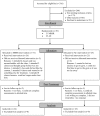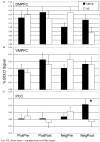Randomized controlled trial of mindfulness-based stress reduction versus aerobic exercise: effects on the self-referential brain network in social anxiety disorder
- PMID: 23133411
- PMCID: PMC3488800
- DOI: 10.3389/fnhum.2012.00295
Randomized controlled trial of mindfulness-based stress reduction versus aerobic exercise: effects on the self-referential brain network in social anxiety disorder
Abstract
Background: Social anxiety disorder (SAD) is characterized by distorted self-views. The goal of this study was to examine whether mindfulness-based stress reduction (MBSR) alters behavioral and brain measures of negative and positive self-views.
Methods: Fifty-six adult patients with generalized SAD were randomly assigned to MBSR or a comparison aerobic exercise (AE) program. A self-referential encoding task was administered at baseline and post-intervention to examine changes in behavioral and neural responses in the self-referential brain network during functional magnetic resonance imaging. Patients were cued to decide whether positive and negative social trait adjectives were self-descriptive or in upper case font.
Results: Behaviorally, compared to AE, MBSR produced greater decreases in negative self-views, and equivalent increases in positive self-views. Neurally, during negative self versus case, compared to AE, MBSR led to increased brain responses in the posterior cingulate cortex (PCC). There were no differential changes for positive self versus case. Secondary analyses showed that changes in endorsement of negative and positive self-views were associated with decreased social anxiety symptom severity for MBSR, but not AE. Additionally, MBSR-related increases in dorsomedial prefrontal cortex (DMPFC) activity during negative self-view versus case were associated with decreased social anxiety related disability and increased mindfulness. Analysis of neural temporal dynamics revealed MBSR-related changes in the timing of neural responses in the DMPFC and PCC for negative self-view versus case.
Conclusion: These findings suggest that MBSR attenuates maladaptive habitual self-views by facilitating automatic (i.e., uninstructed) recruitment of cognitive and attention regulation neural networks. This highlights potentially important links between self-referential and cognitive-attention regulation systems and suggests that MBSR may enhance more adaptive social self-referential processes in patients with SAD.
Keywords: brain; exercise; fMRI; meditation; mindfulness; self; self-view; social anxiety.
Figures










Similar articles
-
Mindfulness Meditation Training and Self-Referential Processing in Social Anxiety Disorder: Behavioral and Neural Effects.J Cogn Psychother. 2009 Aug;23(3):242-257. doi: 10.1891/0889-8391.23.3.242. J Cogn Psychother. 2009. PMID: 25568592 Free PMC article.
-
Self-views in social anxiety disorder: The impact of CBT versus MBSR.J Anxiety Disord. 2017 Apr;47:83-90. doi: 10.1016/j.janxdis.2017.01.001. Epub 2017 Jan 10. J Anxiety Disord. 2017. PMID: 28108059 Free PMC article. Clinical Trial.
-
Evaluation of Cognitive Behavioral Therapy vs Mindfulness Meditation in Brain Changes During Reappraisal and Acceptance Among Patients With Social Anxiety Disorder: A Randomized Clinical Trial.JAMA Psychiatry. 2021 Oct 1;78(10):1134-1142. doi: 10.1001/jamapsychiatry.2021.1862. JAMA Psychiatry. 2021. PMID: 34287622 Free PMC article. Clinical Trial.
-
Mindfulness and bodily distress.Dan Med J. 2012 Nov;59(11):B4547. Dan Med J. 2012. PMID: 23171754 Review.
-
Neural Correlates of Self-referential Processing and Their Clinical Implications in Social Anxiety Disorder.Clin Psychopharmacol Neurosci. 2019 Feb 28;17(1):12-24. doi: 10.9758/cpn.2019.17.1.12. Clin Psychopharmacol Neurosci. 2019. PMID: 30690936 Free PMC article. Review.
Cited by
-
Cognitive benefits of exercise interventions: an fMRI activation likelihood estimation meta-analysis.Brain Struct Funct. 2021 Apr;226(3):601-619. doi: 10.1007/s00429-021-02247-2. Epub 2021 Mar 6. Brain Struct Funct. 2021. PMID: 33675397 Review.
-
The effects of an 8-week mindful eating intervention on anticipatory reward responses in striatum and midbrain.Front Nutr. 2023 Aug 11;10:1115727. doi: 10.3389/fnut.2023.1115727. eCollection 2023. Front Nutr. 2023. PMID: 37637944 Free PMC article.
-
Change in Decentering Mediates Improvement in Anxiety in Mindfulness-Based Stress Reduction for Generalized Anxiety Disorder.Cognit Ther Res. 2015 Apr;39(2):228-235. doi: 10.1007/s10608-014-9646-4. Epub 2014 Oct 14. Cognit Ther Res. 2015. PMID: 28316355 Free PMC article.
-
Meta-analyses of the neural mechanisms and predictors of response to psychotherapy in depression and anxiety.Neurosci Biobehav Rev. 2018 Dec;95:61-72. doi: 10.1016/j.neubiorev.2018.09.022. Epub 2018 Sep 29. Neurosci Biobehav Rev. 2018. PMID: 30278195 Free PMC article. Review.
-
Experimental effects of brief, single bouts of walking and meditation on mood profile in young adults.Health Promot Perspect. 2018 Jul 7;8(3):171-178. doi: 10.15171/hpp.2018.23. eCollection 2018. Health Promot Perspect. 2018. PMID: 30087839 Free PMC article.
References
-
- American Psychiatric Association. (1994). Diagnostic and Statistical Manual of Mental Disorders. Washington, DC: American Psychiatric Association
-
- Baer R. A. (2003). Mindfulness training as a clinical intervention: a conceptual and empirical review. Clin. Psychol. 10, 125–14310.1093/clipsy.bpg015 - DOI
-
- Bradley M. M., Lang P. J. (1999). Affective Norms for English Words (ANEW) Technical Manual and Affective Ratings. Gainsville, FL: Center for Research in Psychophysiology, University of Florida
Grants and funding
LinkOut - more resources
Full Text Sources

